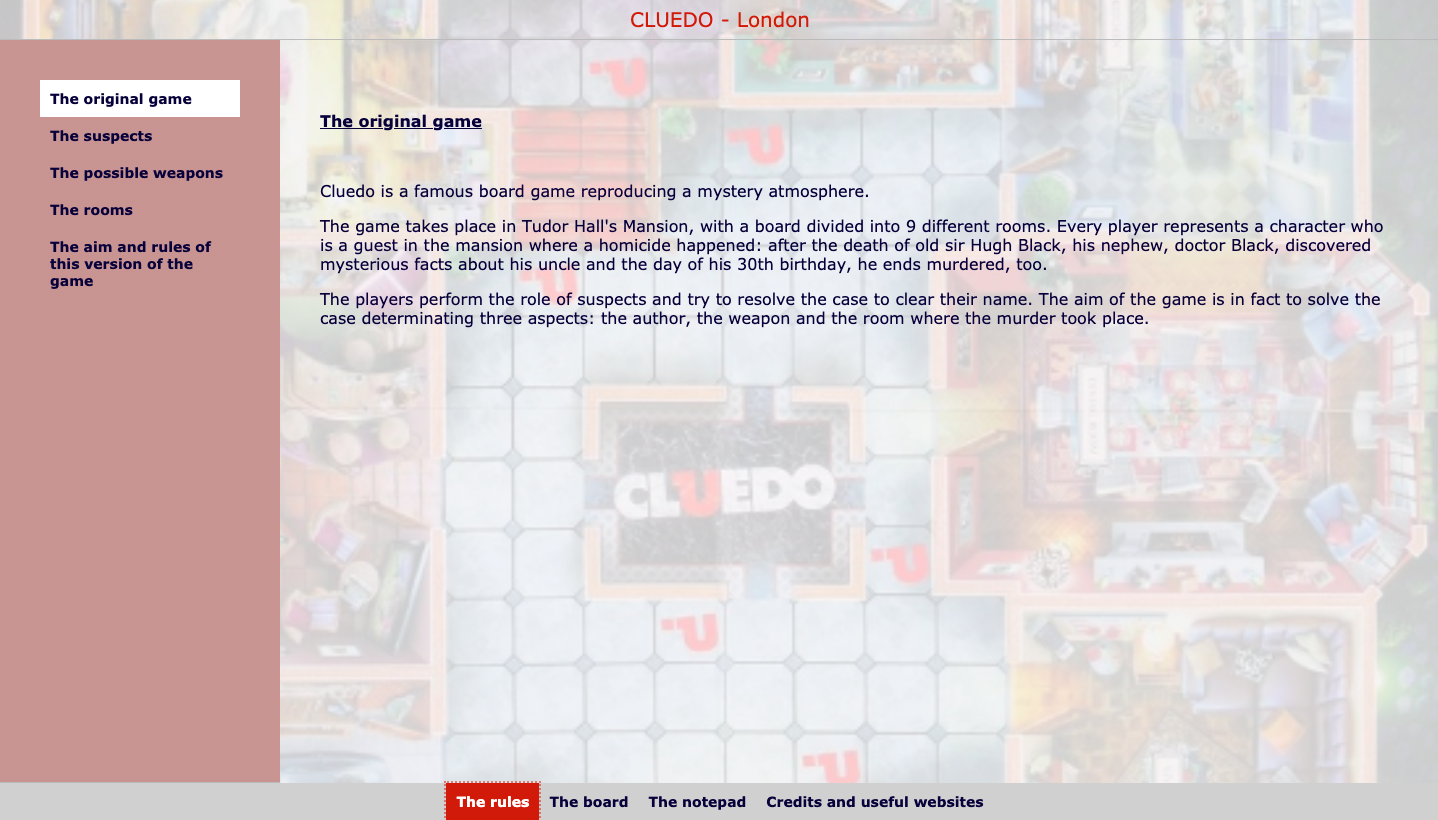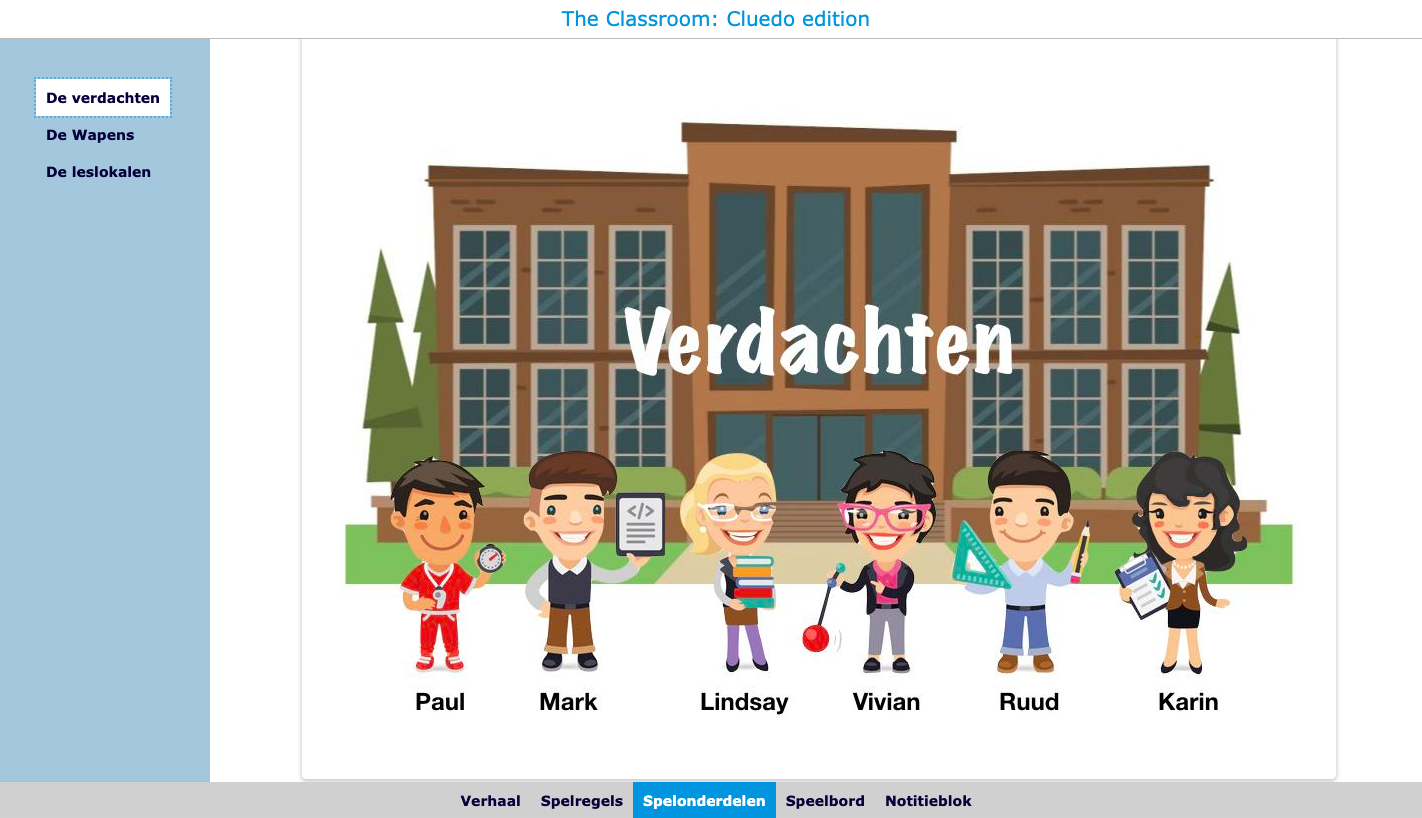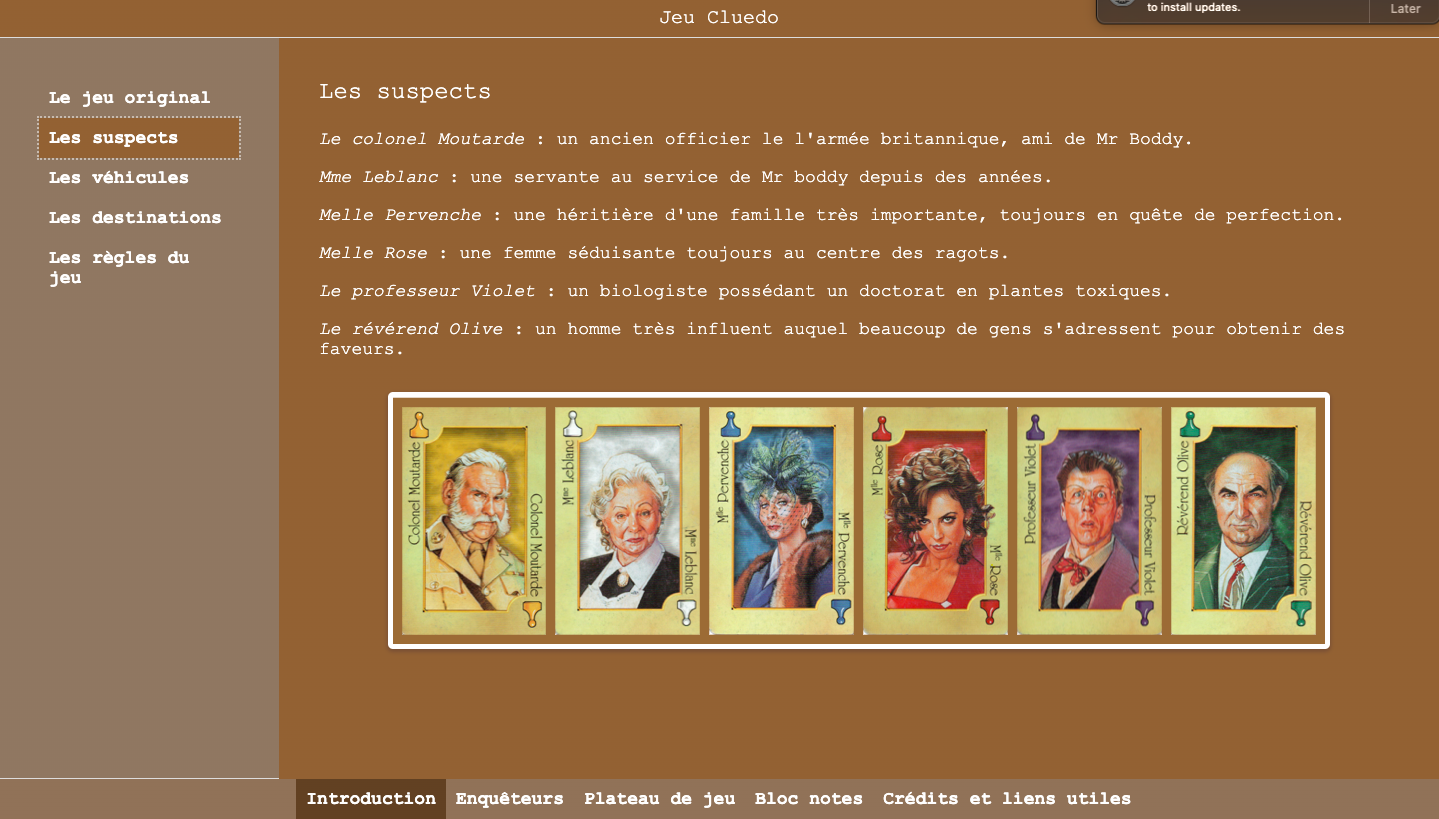How to create a digital cluedo game for in your classroom
 Maude Moors & Lucie Renard —
Maude Moors & Lucie Renard —
In Mrs. White’s villa, something horrific happened last night… There was a fancy party going on until a loud scream interrupted it. Dum dum dummm. (horror sound) One of the guests was murdered! But who did it?
Remember the board game “Cluedo”? (Another name is a murder mystery game or clue.) In this game, someone is murdered. As a player, you have to figure out who did it, what the murder weapon is, and in what room the murder happened.
In this blog post, I will show you how to create a digital Cluedo game with BookWidgets and when to use it in your classroom.
We have made an example for you of an online Cluedo game, and will explain how to make a digital Cluedo game yourself. We’ll also show you some ready-to-use Cluedo game examples, created by the BookWidgets teachers that inspired us to create our own.
To get an idea of what we’re talking about, have a look at the murder mystery game example we created for you:
When to use a Cluedo game?
 Clue games are fun, but they need to have an educational value as well. So, when is the right time to incorporate a digital game of clue in your lessons? Here are some ideas:
Clue games are fun, but they need to have an educational value as well. So, when is the right time to incorporate a digital game of clue in your lessons? Here are some ideas:
1. Language lessons
Use a Cluedo game in your classroom when you want your students to learn a (foreign) language. Cluedo games are based upon finding clues and figuring out the story behind the characters in the game. So, if you’re looking for a fun way to teach a language, just create a murder mystery game for English lessons, Spanish lessons, …
2. Lesson content
A Cluedo game can be designed in a way that students go through different areas while they have to get clues after solving exercises about a certain topic.
3. Open school days
You can also welcome parents and students on your open school days in a creative way. Let them discover your complete school while they are looking for clues and figuring out a murder. Tip: It’s always a good idea to combine the digital with the physical classroom. You can, for example, refer to clues hidden in the real classroom from within your digital Cluedo game.
How to make a digital Cluedo game?
 You probably know the Cluedo board game with all the pawns and the rooms drawn on the game board. With creativity and a solid educational tool, you can transform the Cluedo board game into a digital one. Just follow the steps below, and by the end of this post you’ll have your own murder mystery game. If not…. we have some ready-to-use Cluedo games for you at the end of this post.
You probably know the Cluedo board game with all the pawns and the rooms drawn on the game board. With creativity and a solid educational tool, you can transform the Cluedo board game into a digital one. Just follow the steps below, and by the end of this post you’ll have your own murder mystery game. If not…. we have some ready-to-use Cluedo games for you at the end of this post.
Let’s get started!
1. Choose your tool
Obviously, since this is the BookWidgets blog, we’ll be using BookWidgets to create this murder mystery game. BookWidgets has a large library of exercise templates you can all use together in a single WebQuest widget. Many widgets (or exercise templates) can be used to hide clues, give explanations, and support a mysterious storyline.
The WebQuest widget allows you to create the structure of your Clue game. It’s still a game, so students will need good directions and a clear storyline to follow. You can create this structure by adding different tabs and sections in your WebQuest.
To see how a WebQuest works, watch this webinar which shows you all the different aspects:
2. Develop your storyline
Start by creating your storyline, and think through everything. Who are your characters? Who was murdered? What are the stories behind the characters? And, most importantly, how will you reveal all these parts of your story in the online murder mystery game?
It’s best to start by naming your tabs in the WebQuest. This will be the top structure of your game. In our example below, you can find four tabs, each divided into multiple sections:
- The game: describes the setting, starts the story, indicates the goal
- Choose your character: to fully immerse students in the story, they have to choose their own character, just like in the traditional board game.
- The gameboard: What did happen, and where? Where were all the characters at the time of the murder? The gameboard visualizes the story. Students go through all the “rooms” and find clues. Add widgets in your gameboard so students can bring out their inner detective.
- Detective notes: let students keep track of what they have figured out, step by step, along their way through the gameboard. This is also where students find out if they did find the murderer.
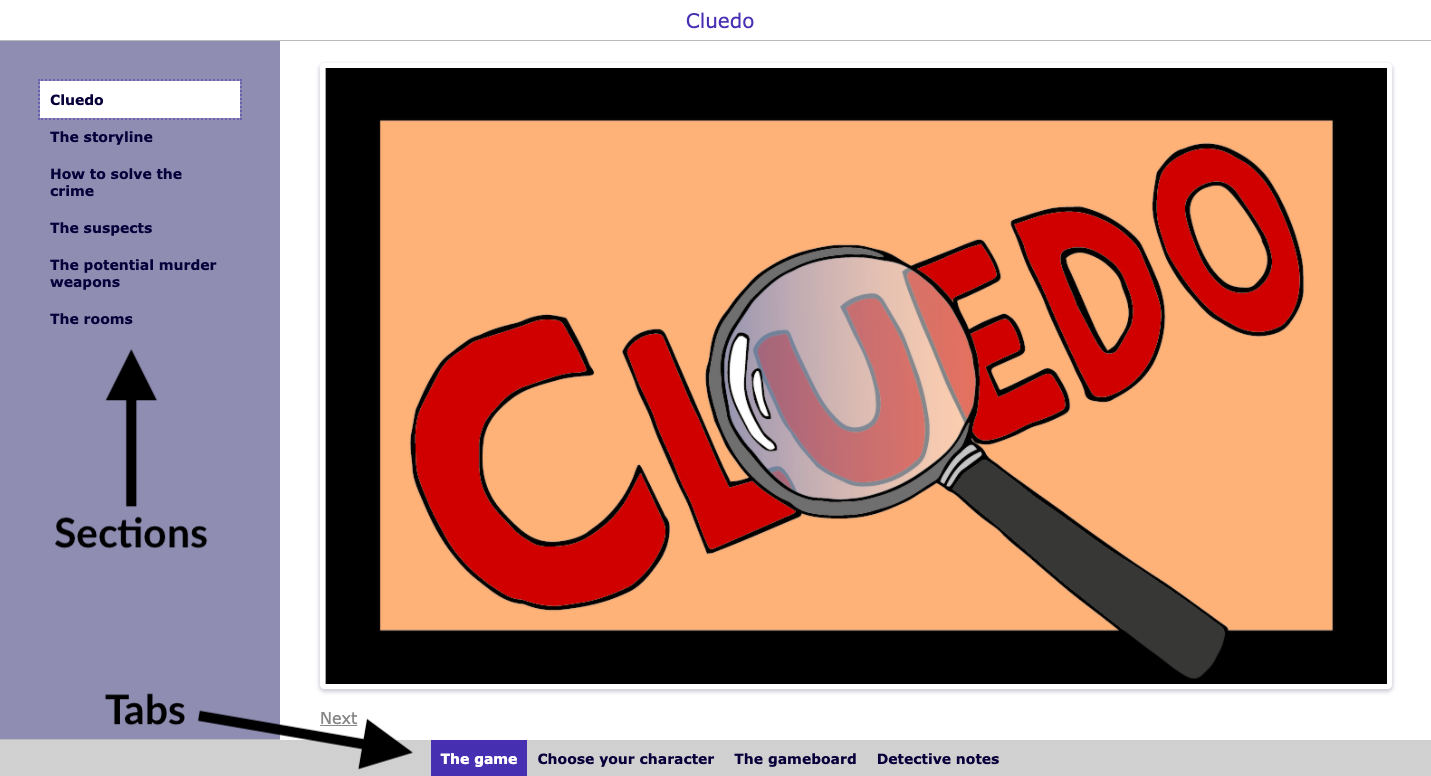
Of course, you can give your tabs another name as well.
3. Design your gameboard
This is probably the most challenging part: you have to design a visual gameboard that will guide students through different rooms or areas in your Clue game.
The traditional Cluedo game is set in a mansion or villa with many different rooms you can draw or use images for.
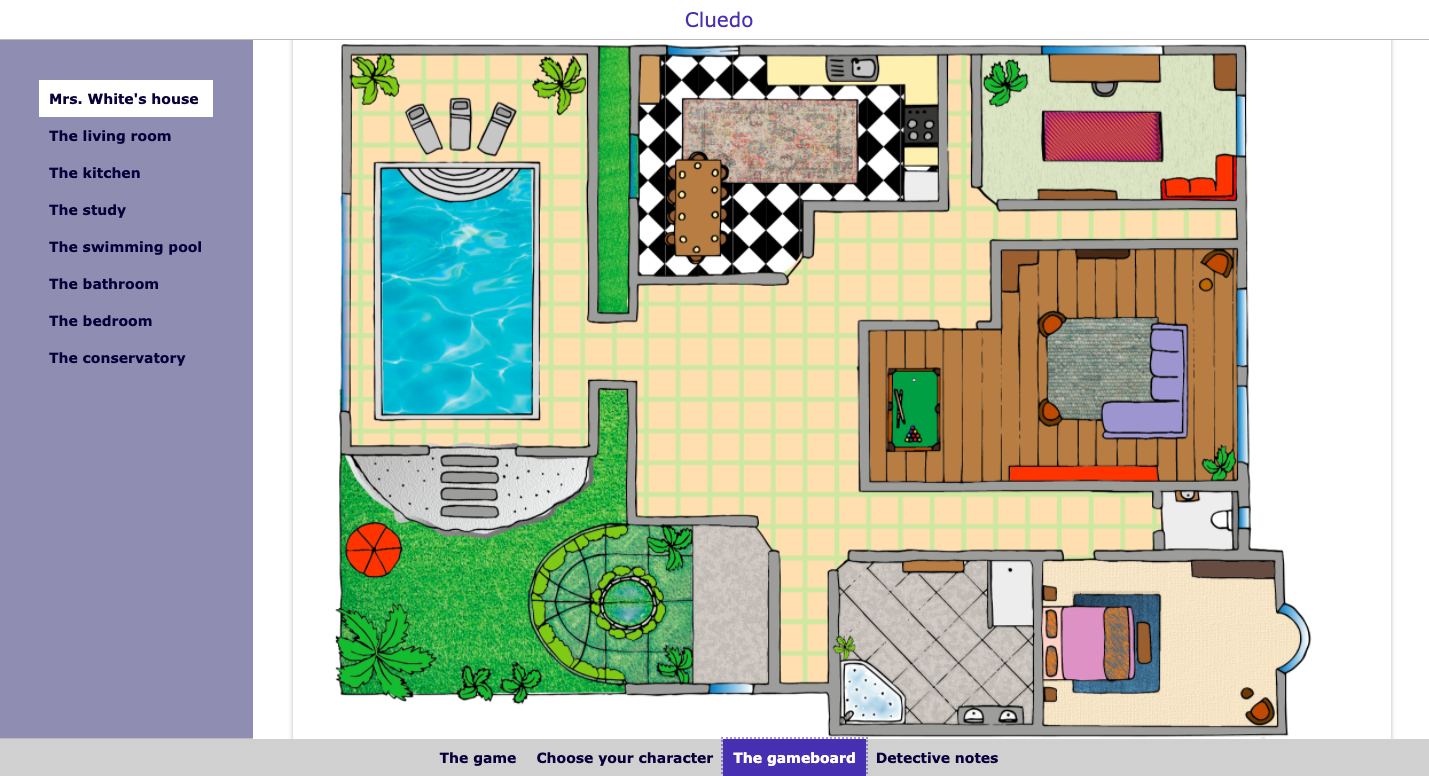
If you want to get really creative, you can switch things around and design a different gameboard. You can use your school as a gameboard, and actual teachers and school staff as the characters.
Other fun Cluedo gameboard settings could be:
- An amusement park
- A fair
- The royal gardens
- A hotel
- A camping site
- A shopping center
- A zoo
Tip: you can choose a gameboard design in line with the new vocabulary you’re teaching your students.
Make sure you create the setting by showing the complete gameboard first. Then, along the way, split up the different area’s so you can guide students through the different rooms where they have to find the clues and unravel the plot of the story.
4. Add challenges and clues
This is the part where you add interactivity. Use different widget types to tell the rest of your story and hide clues. Students have to solve puzzles, search for clues, and actively figure things out.
You can go pretty far with this. But for your first game of clue, we kept it basic. Here are three widgets you absolutely need to use in your WebQuest widget:
- The hotspot widget: To hide pop-ups with text, images, audio, and video in a scene (or image).
- A jigsaw puzzle widget: To create an interactive fun-element with a hidden clue when students complete the puzzle.
- A worksheet widget: To give students a “notebook”, so they can write down thoughts and eventually check if they are right.
Other widgets that are always good for a story in which you can hide clues: the memory widget (a character has memory loss), pair matching (pair up characters with their job or something that defines them), arithmetic (DNA-test that reveals the character), Word search (let students look for significant words that give away a clue in the end).
5. Add a notebook that reveals the secrets
When your students think they have found the solution, they can keep track of their findings and add it to the notebook. In the end, students will see if they were right. If not, something probably went wrong and they will have to try again.
For the notebook, we used a worksheet widget. Students get an automatic feedback message (General > Correction options > Feedback) that reveals all the pieces of the puzzle, only if students got everything right in the worksheet. They have to get at least 99% on their worksheet.
Ready-to-use digital Cluedo game examples
 As we mentioned at the beginning, we got inspired by other teachers first. We’d like to put their Cluedo games in the spotlight as well.
As we mentioned at the beginning, we got inspired by other teachers first. We’d like to put their Cluedo games in the spotlight as well.
Sharon Widmer originally created this Italian Cluedo game. Our widget is completely inspired by hers, so thanks for giving us this idea!
She also translated it to English, while another teacher, Yolande Doensen, translated it to Spanish. Just pick the right language, and share the Cluedo game with your students!
The other widget we wanted to show is a Dutch one, from Robin Ramaekers. This teacher made characters of teachers in his school. Students need to solve the mystery by going from one classroom into the other. Here, students need to apply the course’s learning materials when they enter the virtual classroom.
Since we published this post, teachers started translating these examples themselves. So, we’re very glad that we can update this post with a German version of a Cluedo game from Eva Robyn. You can use this right away! Just share the link to this Cluedo game with your students.
There’s also a French Clue game version created by Vincent Dupont where students have to solve the murder of Mr Boddy. At each tourist location, students must answer questions about the European Union. When they have answered correctly, they receive one or two clues to identify the murderer. At the end of all the steps they will know the murderer, the vehicle he used and the place where he left. Links to websites help students if they get stuck.
Wrap up
I hope these examples and the tips on how to make your own Cluedo game have inspired you to try out one of these or to create your own murder mystery game for in the classroom.
What’s your favorite murder mystery game? Let us know on Twitter and join our Teaching with BookWidgets Facebook group to share your own Cluedo game with other teachers.
Get started here:



